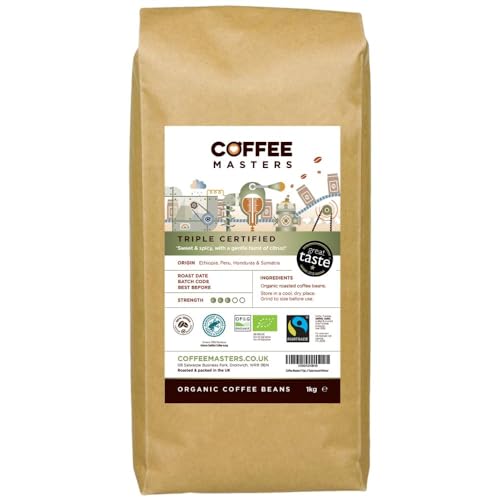10 Quick Tips About Coffee Beans Types

Coffee Bean Types: Arabica, Robusta, Liberica, and Excelsa
If you're a coffee lover you're probably aware that different varieties of beans can produce different flavors. Read on to learn about four of the most well-known varieties: Arabica, Robusta, Liberica and Excelsa.
Excelsa beans are a kind of Liberica that is grown exclusively in Southeast Asia. They have a fruitier and tarter flavor, and are often added to blends of beans to enhance the flavor.

Arabica
Arabica is the most sought-after coffee in the world with 75% of global coffee beans produced. Arabica beans are milder and sweeter than Robusta. They also are available in a variety of flavours. The taste and aroma components of a cup of coffee can differ widely depending on the growing conditions and processing methods used to make it.
The word 'coffee' actually derives from the Arabic word for berry and coffee beans are fruit seeds that grow inside bright red berries. It is believed that the ancient Ethiopian shepherds noticed that their goats were more energetic after eating the berries, and the cultivation of coffee quickly began to spread throughout the world.
Coffee beans can be grown at higher altitudes, and are able to thrive in cold temperatures and plenty of rain. This is why Arabica coffee is believed to be the most delicious kind of coffee.
Many specialty coffee shops and roasters concentrate on the ethical source of arabica beans, and focusing on fair wages for farmers and sustainable farming practices. These companies blend arabica beans to create unique signature coffees that are suitable for a variety of brewing methods. Blending allows for control over the aroma, flavor as well as body and acidity of the coffee and is usually preferred to achieve a balanced and consistent taste that appeals to a larger market.
Robusta
Robusta beans are the second-most popular type of coffee bean in the world. They contain more caffeine per bean and are more resistant against pests and diseases. They also contain higher levels of chlorogenic acid, which are antioxidants found naturally. However, these acids can cause oxidation in the process of brewing coffee and may result in undesirable flavors.
The plant is more resilient than the arabica and is able to thrive in less favorable conditions. It can withstand warmer temperatures and thrives in direct sunlight. It produces more coffee per plant, and it grows faster than arabica. This makes it a economically viable crop to cultivate.
While it may seem counterintuitive, Robusta and arabica beans are often blended to create coffee blends. If you've seen the names of countries such as Uganda or Kenya on a bag of coffee, it's likely that there's some Robusta in there as well.
Although some roasters only use arabica beans, most do a mix of the two varieties to reduce costs and preserve quality. To preserve the integrity of flavor it is recommended to select an excellent bean from a trusted source. The best way to achieve this is to buy your beans directly from the farmer.
Liberica
Liberica beans are more or less football shaped, which makes them distinct from other types of coffee beans. They have a scent that is floral, fruity and smoky. They are often blended with other coffee bean varieties to add a fuller, more robust flavor.
Liberica coffee beans are available in West Africa, Malaysia (Borneo) and Southeast Asia. They can grow in low altitudes and can withstand humid, hot climates. They are also more resistant to disease than Arabica or Robusta.
These characteristics make them ideal to grow at home. You can purchase seeds online from a number of sources, but it's recommended to purchase from local producers to guarantee the quality of the beans. The ideal conditions for the cultivation of Liberica coffee include fertile deep volcano soils with a pH that is moderately acidic and adequate annual rainfall.
Excelsa is a different type of coffee bean. It was previously classified as a distinct species, but has been reclassified as a Liberica variant. These coffee beans are ovals that grow on large 20 to 30-foot coffee plants that are situated at medium altitudes. Their distinctive flavor is tart and sour, making them a popular option for blends made at home. They are also lighter in aroma and caffeine than Arabica and Robusta yet still possess a unique depth of flavor.
Excelsa
Excelsa coffee beans aren't as common as Arabica and Robusta yet they're the fourth most popular. They were considered to be to be a different species of coffee until 2006, when they were reclassified to be a synonym for Coffea Liberica var. dewevrei. They are produced in Southeast Asia today and account for 7% of the world's production of coffee. The coffee beans are shaped like a teardrop and have a dark, mysterious taste. These beans are commonly used to give blends additional body and a rich tart taste of ripened fruits.
top 10 coffee beans Coffeee are the most sought-after, and are well-known for their an apricot-like flavor. They grow best at high altitudes and have warm, tropical climates. They also have a bit of acidity. If properly roasted and brewed they may be flavored with notes of nuts, chocolate, or even fruit.
Robusta is a close second only to Arabica and is responsible for about 40 percent of the world's coffee. These beans are smaller and more round however, they contain twice as much caffeine as Arabica. They are also more bitter than the other two varieties and have an earthy, woody flavor.
After you've learned about the four most common types of coffee beans now is the time to pick your ideal coffee. If you prefer an elegant and delicate taste pick an arabica or a blend of robusta and arabica beans.
